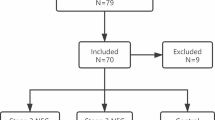Abstract
Both early diagnostic and prognostic assessment of the acute abdomen in preterm infants are hampered by the lack of a sensitive and specific parameter for intestinal injury. In this prospective clinical study we wanted to estimate the value of intestinal (I-) and liver (L-) fatty acid binding protein (FABP) in diagnosing necrotizing enterocolitis (NEC). Using highly sensitive and specific sandwich ELISAs which employ recombinant human I- and L-FABP as standard proteins (limit of detection 0.1 ng/ml plasma), the L-FABP concentration (median 7.6 ng/ml) was determined to be about 3 fold that of I-FABP (median 2.52 ng/ml) in plasma of healthy preterm infants. I- and L-FABP concentrations significantly increased with birth weight (1.6 and 5.0 ng/ml per kg, respectively). At onset of symptoms, I-FABP concentration was significantly higher in infants who later developed severe NEC compared to healthy infants and those, whose illness remained confined to stage I or II. L-FABP was significantly elevated compared to the control group at onset of symptoms regardless of the further course of NEC. In conclusion, I-FABP appears to be a specific parameter for early detection of intestinal injury leading to severe NEC stage III. L-FABP, however, is a promising sensitive marker even for stage I of NEC.
Similar content being viewed by others
References
Crissinger KD, Balistreri WF: Gastrointestinal hemorrhage. In: A.A. Fanaroff, R.J. Martin (eds). Neonatal-Perinatal Medicine: Diseases of the Fetus and Infant, 6th edn. Mosby-Year Book Inc., St. Louis, 1997, pp 1331–1333
Sacchettini JC, Hauft SM, Van-Camp SL, Cistola DP, Gordon JI: Developmental and structural studies of an intracellular lipid binding protein expressed in the ileal epithelium. J Biol Chem 265: 19199–19207, 1990
Kanda T, Nakatomi Y, Ishikawa H, Hitomi M, Matsubara Y, Ono T, Muto T: Intestinal fatty acid-binding protein as a sensitive marker of intestinal ischemia. Dig Dis Sci 37: 1362–1367, 1992
Gollin G, Marks C, Marks WH: Intestinal fatty acid binding protein in serum and urine reflects early ischemic injury to the small bowel. Surgery 113: 545–551, 1993
Gollin G, Marks WH: Elevation of circulating intestinal fatty acid binding protein in a luminal contents-initiated model of NEC. J Pediatr Surg 28: 367–370, 1993
Lieberman JM, Sacchettini J, Marks C, Marks WH: Human intestinal fatty acid binding protein: Report of an assay with studies in normal volunteers and intestinal ischemia. Surgery 121: 335–342, 1997
Edelson MB, Sonnino RE, Bagwell CE, Lieberman JM, Marks WH, Rozycki HJ: Plasma intestinal fatty acid binding protein in neonates with necrotizing enterocolitis: a pilot study. J Pediatr Surg 34: 1453-1457, 1999
Walsh MC, Kliegman RM: Necrotizing enterocolitis: treatment based on staging criteria. Pediatr Clin North Am 33: 179–201, 1986
Wolfrum C, Buhlmann C, Rolf B, Börchers T, Spener F: Variation of liver-type fatty acid binding protein content in the human hepatoma cell line HepG2 by peroxisome proliferators and antisense RNA affects the rate of fatty acid uptake. Biochim Biophys Acta 1437: 194–201, 1999
Sweetser DA, Birkenmeier EH, Klisak IJ, Zollman S, Sparkes RS, Mohandas T, Lusis AJ, Gordon JI: The human and rodent intestinal fatty acid binding protein genes. A comparative analysis of their structure, expression, and linkage relationships. J Biol Chem 262: 16060–16071, 1987
Gill SC, von Hippel PH: Calculation of protein extinction coefficients from amino acid sequence data. Anal Biochem 182: 319–326, 1989
Sonntag J, Wagner MH, Waldschmidt J, Wit J, Obladen M: Multisystem organ failure and capillary leak syndrome in severe necrotizing enterocolitis of very low birth weight infants. J Pediatr Surg 33: 481–484, 1998
Baier LJ, Sacchettini JC, Knowler WC, Eads J, Paolisso G, Tataranni PA, Mochizuki H, Bennett PH, Bogardus C, Prochazka M: An amino acid substitution in the human intestinal fatty acid binding protein is associated with increased fatty acid binding, increased fat oxidation, and insulin resistance. J Clin Invest 95: 1281–1287, 1995
Schreiber A, Specht B, Pelsers MMAL, Glatz JFC, Börchers T, Spener F: Recombinant human heart-type fatty acid-binding protein as standard in immunochemical assays. Clin Chem Lab Med 36: 283–288, 1998
Kanda T, Fujii H, Tani T, Murakami H, Suda T, Sakai Y, Ono T, Hatakeyama K: Intestinal fatty acid-binding protein is a useful diagnostic marker for mesenteric infarction in humans. Gastroenterology 110: 339–343, 1996
Poirier H, Degrace P, Niot I, Bernard A, Besnard P: Localization and regulation of the putative membrane fatty-acid transporter (FAT) in the small intestine. Comparison with fatty acid-binding proteins (FABP). Eur J Biochem 238: 368–373, 1996
Van Nieuwenhoven FA, Kleine AH, Wodzig WH, Hermens WT, Kragten HA, Maessen JG, Punt CD, Van Dieijen MP, Van der Vusse GJ, Glatz JFC: Discrimination between myocardial and skeletal muscle injury by assessment of the plasma ratio of myoglobin over fatty acid-binding protein. Circulation 92: 2848–2854, 1995
Bell MJ, Ternberg JL, Feigin RD, Keating JP, Marshall R, Barton L: Neonatal necrotizing enterocolitis. Therapeutic decisions based upon clinical staging. Ann Surg 187: 1–7, 1978
Author information
Authors and Affiliations
Rights and permissions
About this article
Cite this article
Guthmann, F., Börchers, T., Wolfrum, C. et al. Plasma concentration of intestinal- and liver-FABP in neonates suffering from necrotizing enterocolitis and in healthy preterm neonates. Mol Cell Biochem 239, 227–234 (2002). https://doi.org/10.1023/A:1020508420058
Issue Date:
DOI: https://doi.org/10.1023/A:1020508420058




